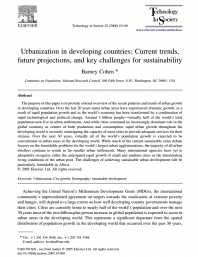
Urbanization in Developing Countries: Current trends, future projections, and key challenges for sustainability

Abstract
The purpose of this paper is to provide a broad overview of the recent patterns and trends of urban growth in developing countries. Over the last 20 years many urban areas have experienced dramatic growth, as a result of rapid population growth and as the world’s economy has been transformed by a combination of rapid technological and political change. Around 3 billion people—virtually half of the world’s total population-now live in urban settlements. And while cities command an increasingly dominant role in the global economy as centers of both production and consumption, rapid urban growth throughout the developing world is seriously outstripping the capacity of most cities to provide adequate services for their citizens. Over the next 30 years, virtually all of the world’s population growth is expected to be concentrated in urban areas in the developing world. While much of the current sustainable cities debate focuses on the formidable problems for the world’s largest urban agglomerations, the majority of all urban dwellers continue to reside in far smaller urban settlements. Many international agencies have yet to adequately recognize either the anticipated rapid growth of small and medium cities or the deteriorating living conditions of the urban poor. The challenges of achieving sustainable urban development will be particularly formidable in Africa.
- Issue:
- Demography, Urbanization and Migration
- Region:
- Global
- Year Published:
- 2005
- Author:
- Barney Cohen
- Institution:
- Technology in Society (Journal)

